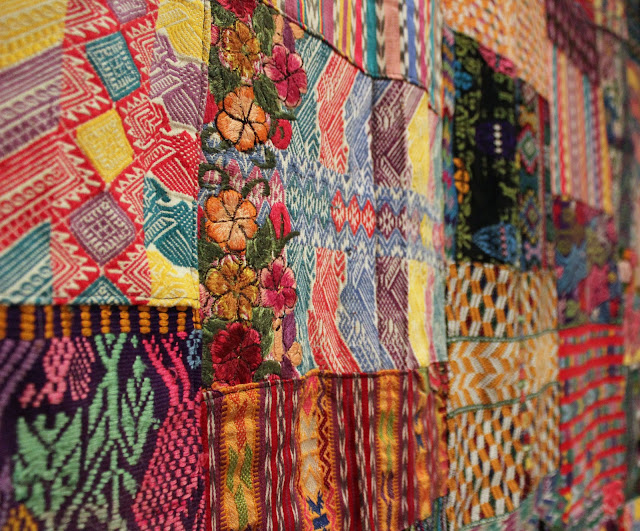Three years ago, I went on an amazing trip to Guatemala with the Habitat for Humanity Global Village program. Our last day there was spent in Antigua, where I bought this beautiful, handmade quilt. It's huge, at 84" by 96". It's been in a closet since I got back from the trip. Sometimes used as guest bedding, but, for the most part, just sitting on a shelf, which is pretty sad for such a beautiful thing with so much sentimental value.
I participated in Apartment Therapy's January Cure this year (so worth it!!), and when we came to the "Hanging Artwork" assignment, I decided it would be a good time to hang the quilt. I'm a month late, but that's ok.
What once was a boring, blank wall ...
... is now a colorful, happy reminder of an incredible trip.
And it really does show that with the right planning, the correct tools, and a good ladder, a job that might look like it requires two people can be fairly easily tackled by one, smallish woman.

The first step was to sew a "quilt
sleeve" for the back of the quilt. There are plenty of tutorials from
real quilt people out there (here is one of the ones I used),
so I won't bore you with the details, but it's basically a tube of
fabric (I used some scrap Ikea curtain fabric) sewed to the back of the
quilt.
The trick is to make it with a little
slack so that your quilt won't bulge when you hang it. You can sew the
sleeve on a sewing machine, but you have to hand-stich the sleeve onto
the back of the quilt, so that it doesn't show from the front.
You also need a rod of some sort to hang the quilt on. I used a piece of pine 1-1/4" x 6/16" molding. (You can see it sitting on the table in the "boring wall" photo above.) Once you have cut the molding or whatever you're using to the correct size, you need to attach screw eyes to both ends.
You then want to take your molding with the screw eyes and measure and attach it to the wall without the quilt on it. The reason for doing this is to check for level before you go to the trouble of hanging the quilt, which is heavier and therefore harder to hang than just the light molding. For now, I have hung it with medium-sized nails with a large head. As soon as I'm ready to commit to a bigger hole in the wall, I plan to go back and replace the nails with sturdier, self-drilling drywall anchors and screws.
Once you're happy with the molding, take it down off the wall and put it through the sleeve. Make sure that you have the molding in the exact same orientation (left, right, front, back) as when you had it on the wall, as it could be bowed (like mine was), and using it in another orientation might change how level it is.
I was lucky to have a sturdy table that I could carefully walk on and use as a sort of platform. I was able to hang the one end of the quilt, then, holding the other end, shimmy across the glass table to hang the other end. I used a ladder when I was measuring and nailing in the nails, but the table was easier for hanging.
I chose to hang the quilt so that the bottom just skims the top of the baseboard molding. And I centered it above the table.
A few more angles:
It makes the room feel so much warmer and makes the table a more inviting place.










0 comments:
Post a Comment